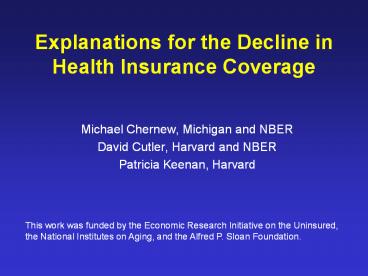Explanations for the Decline in Health Insurance Coverage - PowerPoint PPT Presentation
1 / 20
Title:
Explanations for the Decline in Health Insurance Coverage
Description:
Explanations for the Decline in Health Insurance ... Patricia Keenan, Harvard. This work was funded by the Economic Research Initiative on the Uninsured, the ... – PowerPoint PPT presentation
Number of Views:22
Avg rating:3.0/5.0
Title: Explanations for the Decline in Health Insurance Coverage
1
Explanations for the Decline in Health Insurance
Coverage
- Michael Chernew, Michigan and NBER
- David Cutler, Harvard and NBER
- Patricia Keenan, Harvard
This work was funded by the Economic Research
Initiative on the Uninsured, the National
Institutes on Aging, and the Alfred P. Sloan
Foundation.
2
Research Questions
- What impact will rising premiums have on coverage
in the future? - What role did rising premiums for health
insurance play in declining coverage rates over
the 1990s?
3
Basic Fact
- Despite strong economic growth, and expanding
public coverage, the rate of health insurance
coverage fell during the 1990s. - 13.7 of non-elderly uninsured (1987)
- 15.8 of non-elderly uninsured (2000)
4
Reasons for Decline
- Demographic or labor market changes
- Changing value of alternatives (charity care)
- Equilibrium unraveling
- Increase in working spouses
- Regulatory changes
- Changing Load
- Taxes
- Rising premiums
- 1 increase in premium ? drop of 300,000 (Lewin)
5
Load as a Measure of Price
- Textbook models
- Price is the load (difference between premium
and expected payout) - Rising premiums
- Have no price effect
- May lead to greater coverage if correspond to
greater risk - Most elasticity estimates are load or
co-premium based
6
Why Premiums May Matter
- Higher premiums may include greater moral hazard
cost - Contracting imperfect
- Higher premiums may increase incentives for low
risk to opt out and market to unravel - Higher premiums may increase relative appeal of
charity care - Particularly if better technology (which drives
up premiums) is also partially available via
charity care
7
Approach
- Relate decline in coverage between 1988-1990 and
1998-2000 to increases in premiums - Probit model using individual level data
- Control for
- Individual traits
- Taxes
- Working spouses
- Medicaid expansion
- Immigration
- State insurance regulation
- MSA unemployment
- MSA demographics
- Managed care enrollment
8
Market Data
9
Individual Data
- Insurance Coverage
- Demographics and employment characteristics for
individuals and family head - Time interactions
- Income deciles (Gruber approach)
- Income deciles interacted with marital status of
family head - Income deciles interacted with marital status and
time - Child age dummies, mean medical care spending by
child age (Cutler /Gruber 1996).
10
Base Results
Any Cov. Private
Public
Controls for individual level traits and MSA
demographics included but not displayed.
11
Endogeneity and Attenuation bias
- Noise in premium measure
- Uninsured may cause rising costs
- Selection effects
- Cost shifting
- Instrument with Medicare and State per capita
costs - F-stat 52.66
- Partial R-squared .75
12
Any Cov.
Any Cov. Any Cov.
Probit LPM
LPM - IV
Base Results - IV
Instruments for private premiums are Medicare
Part B and state nonelderly medical spending.
Controls for individual level traits and MSA
demographics included but not displayed.
13
Premium Results by Subgroup
Any Cov. Private
Public
Controls for all covariates in base model.
14
Interpretation
- 1 increase in premiums leads to 150,000 more
uninsured - Half of Lewin effect
- 1 cost growth above GDP leads to 1.8M more
uninsured - 2 cost growth above GDP leads to 3.8M more
uninsured - Mean premium increase (645) accounts for
- 1.7 percentage points decline in coverage
- 54 of mean decline
- Effects greatest for young and low income
15
Conclusions
- Health care cost increases are related to drop in
coverage. - It is reasonable to assume that coverage rates
will continue the long-term decline. - Subsidy and pro-competition strategies may be
short term fixes - Suggests a fundamental challenge to policy makers
- Individuals desire access to new medical
technologies - Costs of coverage may become increasingly less
affordable
16
Explaining Tax Results
- Results are not robust to specification changes
- Very little variation in taxes rates over time
- Fixed effects absorb much of this variation
- Counter-intuitive results likely noise
- We dont focus on groups most likely to be
affected - Private coverage
- Workers
- Workers own employment-based coverage results are
consistent with literature
17
Sensitivity of Any Coverage to Cost Measure
Private premiums
Medicare Pt. B
Controls for individual level traits and MSA
demographics included but not displayed.
18
Other findings
- Medicaid expansions increase coverage 1
percentage point - Some variables reduce private, but not public,
coverage - Working women
- Premiums
- Demographic forces offset
- Income vs. other demographics
19
Focus on Any Coverage
- Advantage
- Broadest measure of coverage trends
- Disadvantage
- Effects may differ in sub-markets
- Private
- Workers
- Own ESI
- Public
20
Model
- Coverage i,m,t
- X i,m,t Bt Zm,t l d m qt e i,m,t
- Standard errors assume clustering by MSAtime































